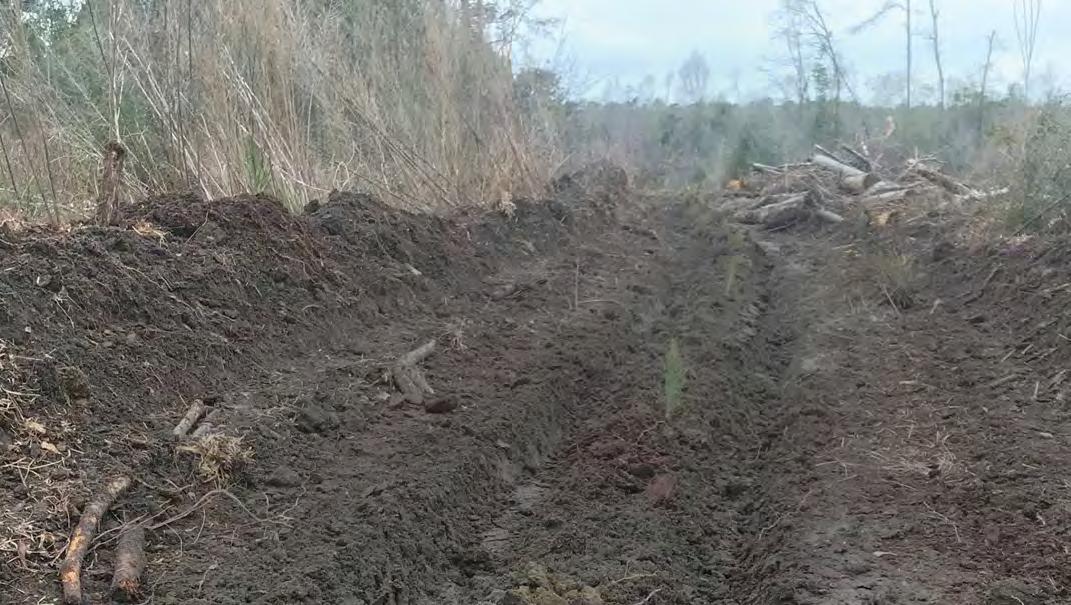
13 minute read
W ASHINGTON REPORT
WASHINGTON REPORT
CORONAVIRUS DELAYS LONG-AWAITED TRADE FIELD HEARINGS
On Jan. 9, the Office of the United States Trade Representative (USTR) promised a series of actions in response to a decades-long plea from Florida agriculture for corrective trade action.
This followed truly heroic efforts by Florida Congressional members and state agricultural leaders throughout the negotiations that led to the signing of the United StatesMexico-Canada Agreement.
One of the commitments made by the USTR office included field hearings in Florida and Georgia to engage directly with growers and owners of agriculture-related businesses affected by unfair trading practices experienced since the implementation of the North American Free Trade Agreement.
The national trade office also pledged that staff members would be working with agricultural producers to “identify and compile documentation on trade distorting policies” and secure further assistance from agencies such as the International Trade Commission and the U.S. Department of Commerce.
In keeping with the January promises, USTR scheduled the first field hearing on April 7 in Plant City, the “winter strawberry capital of the world.” The strawberry has joined a growing list of fruits and vegetables that have succumbed to recent import surges from Mexico.
Unfortunately, the catastrophic spread of the Coronavirus forced a postponement of these hearings. A future date will likely be identified once it is safe again to convene in large gatherings.
Such a public hearing affords an opportunity to Florida farm families who have struggled under these unfair Mexican trade practices for years. It may also be a forum for bygone farmers who could no longer justify staying in business as long as foreign subsidization and dumping remain the norm. By JohnWalt Boatright, Director of National Affairs
Additionally, these field hearings should invoke significant consumer interest. Preserving local farms by fighting for fair trade will help ensure a domestic supply of fresh, abundant and cost-effective food supply. It will also sustain

the economic stimulus to local communities, and the numerous jobs on which those communities and rural families depend.
As an agricultural community, we must remain vigilant as we confront our longstanding, as well as our insurgent, challenges.
Please rest assured, knowing Florida Farm Bureau is working for our members to ensure business can continue as usual without undue disruptions while we cope with the largest public health crisis in a century.


Looking for Agricultural News?
SUBSCRIBE TO FLORIDA FARM BUREAU’S MONTHLY ELECTRONIC NEWSLETTER

Research News Legislative and Policy Updates Farmer Profiles Latest Ag Apps
Sign up for a FREE SUBSCRIPTION at http://www.floridafarmbureau.org/ floridagriculture_enewsletter/
Help us teach students about Agriculture!
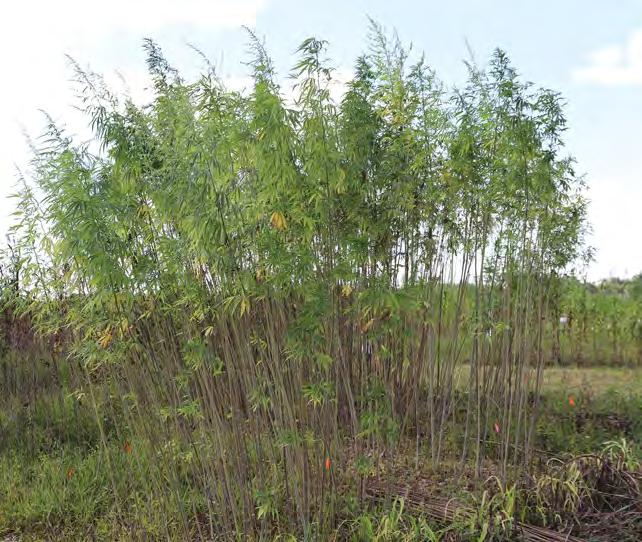

Buy the AgTag® $20 of your purchase helps educate our kids!
Through your purchase of the Florida Agriculture License Plate, Florida Agriculture In The Classroom is able to provide:
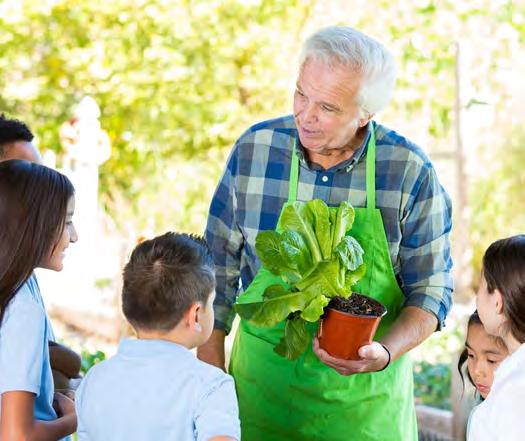
• Funds for school gardens • PreK–12 agriculture curriculum • Teacher and volunteer grants • Workshops and farm tours • Florida Agriculture Literacy Day • And much more!
According to a new report issued by the U.S. Department of Agriculture, industrial hemp has received a big boost in the past seven years from government-sponsored pilot programs.
Acreage reported by such programs across the nation increased from zero in 2013 to over 90,000 acres by 2018.
More than 146,000 acres of industrial hemp are now officially planted.
Researchers at the agency’s Economic Research Service (ERS) noted several challenges that became apparent after these tests were begun: • Th e need for state legislation that allowed hemp to be grown or cultivated • Th e difficulty of acquiring critical production inputs such as seeds, insecticides herbicides and credit • Th e inconsistency of various state requirements • The lack of basic data and information for farm decision making
The ERS cautions that, as with other crops, hemp will not be economically viable in every state. Farmers are not likely to plant or process hemp if more profitable options exist.
Future viability of hemp production will be affected by a combination of factors: • Competition from other domestic crops for acreage • Global competitors in hemp and hemp products • The availability of market information and transparency • Th e regulatory environment
There is no uniform, comprehensive data source for the emerging crop or a requirement to report a consistent set of data for the pilot programs.
The USDA report is posted at http://bit.ly/38VbhtV. USDA: INDUSTRIAL HEMP FACES CHALLENGES
11 Florida locations to serve you.


Shop Online at
AgProCo.com
for a FREE On-Farm Readiness Review Sign up

The Food Safety Modernization Act (FSMA) Produce Safety Rule (PSR) inspections have begun. Sign up now to request a free On-Farm Readiness Review (OFRR), offered in partnership by the Florida Department of Agriculture and Consumer Services and University of Florida IFAS. The OFRR is an educational opportunity to help individual farms align practices with the PSR regulatory requirements in preparation for inspections.
For more information on FSMA and to sign up for an OFRR, visit FDACS.gov/FSMA or call (863) 578-1900.
To take full advantage of the OFRR and for PSR compliance, one farm representative should first attend a Produce Safety Alliance Grower Training. Upcoming trainings can be found at: crec.ifas.ufl.edu/extension/events
Funding for this statement was made possible, in part, by the Food and Drug Administration through grant PAR-16-137. The views expressed in this publication do not necessarily reflect the official policies of the Department of Health and Human Services.
A Stable Relationship
Researchers have shown that some freeze-dried berry powders – especially freeze-dried strawberry powder – can act as outstanding stabilizers in ice cream and other frozen dairy desserts.
Freeze-dried strawberry powder is such an effective stabilizer that frozen dairy desserts with it included will maintain their shape even after reaching room temperature, according to Agricultural Research Service research food technologist Cristina Bilbao-Sainz with the Healthy Processed Foods Research Unit in Albany, California.
To be technically classified as ice cream, it must contain between 10% and 16% milkfat; everything else is called a frozen dairy dessert.
Without a stabilizer, ice cream – home-made or commercial – can become unpleasantly crunchy with the growth of large ice crystals. It can happen in either or both the ice
FREEZE-DRIED
STRAWBERRIES AND ICE CREAM By Kim Kaplan, USDA/ARS


cream maker or the freezer, when temperatures change.
Stabilizers also slow down melting, prevent wheying off (the leaking of a clear watery serum), help avoid shrinking during storage and increase the perception of creaminess.
Standard stabilizers such as sodium alginate, guar gum, iota carrageenan, xanthan gum and carboxymethyl cellulose are commonplace. But people tend to react negatively to these unfamiliar, chemical sounding names when they appear on an ice cream label, assuming these must be artificial ingredients.
Actually, many do come from natural sources. For example, sodium alginate is extracted from brown seaweed.
Bilbao-Sainz became intrigued with the idea of freeze-dried fruit powders as ice cream stabilizers when an all-natural dessert maker came looking for scientific facts about them. The possibilities of freeze-dried fruit powder have been previously known but not technically quantified.
“We discovered that some of the freeze-dried fruit powders – especially strawberries – completely prevent the melt-down of dairy frozen desserts similar to ice cream made with whole milk, whole whipping cream, sugar and skim milk powder,” Bilbao-Sainz said.
“Freeze-dried berry powder will absorb moisture from the premix base, improving its stability and texture to the point where the frozen dessert will keep its shape even after ‘melting’ to room temperature.”
In Bilbao-Sainz's testing, adding 3.5% of either strawberry, raspberry or blackberry freeze‐dried powder reduced the water available for ice crystal formation during stirring and freezing, preventing crystal growth and slowing melting. That translates to adding about 0.7 ounces for a 1-quart home ice cream maker.
Strawberry powder was the best stabilizer, completely preventing melt‐down, followed closely by raspberry. While blackberry powder prevented the frozen dessert from wheying off, the foam structure still collapsed, so it lost its original shape.
Using freeze-dried strawberry powder as a stabilizer in frozen dairy desserts such as ice creams also means accounting for the added strawberry flavoring.
Stress Management RESOURCES FOR FARM FAMILIES

According to opinion polls as well as informal discussions, financial risk is a major source of stress for farmers and ranchers.
Adverse weather, market conditions, labor shortages and plant and animal disease, among various other forces, create daily pressures. No one is immune to the effects they impose over time.
In a national poll of farmers and farmworkers commissioned by the American Farm Bureau Federation (AFBF), 91% of the respondents agreed that financial issues affected their overall mental health. The poll also indicated that farmers are less likely than other rural residents to spot warning signs of negative stress impact.
In response, the AFBF has partnered with Michigan State University, Farm Credit and National Farmers Union to offer a Rural Resilience Training Program at no cost to Farm Bureau members.
The program will give participants the skills to understand the sources of stress, learn the warning signs of stress and suicide, identify effective communication strategies, reduce stigma related to mental health concerns and connect farmers and ranchers with appropriate mental health and other resources.
Farm Bureau members may register for this online training at http://bit.ly/3barwnz.
Florida Farm Bureau has provided multiple resources for help with stress management. Visit “Coping with Stress” under Quick Links of www.floridafarmbureau.org.

UF OFFERS SELECT High School
Program
This summer, Florida high school students will have the opportunity to experience college life at the University of Florida while learning how the agricultural, natural resource and life sciences impact their families and communities around the world.
Selected high school juniors and seniors will participate in the Florida Youth Institute (FYI), a weeklong summer program sponsored by the UF/IFAS College of Agricultural and Life Sciences (CALS), the Florida Department of Agriculture and Consumer Services (FDACS) and The World Food Prize Foundation.
“To be considered for FYI, I wrote a short essay examining solutions to nutritional access in Alachua County. I learned the need for locally fine-tuned answers that empower children and families by bringing them closer to their food’s production,” said Kavina Peters, a 2019 FYI participant and a junior at Eastside High School.
“Participating in FYI gave me hope in my generation’s ability to help end food insecurity in our world. Change starts with asking how we can help.”
FYI participants will: • Engage in hands-on activities and demonstrations. • Experience indoor and outdoor laboratories and campus facilities. • M eet CALS Dean Elaine Turner, faculty, staff members and current students as well as FDACS personnel. • Examine issues in agriculture, life sciences and natural resources. • E xperience one week in a campus residence hall. • Reflect on worldwide challenges such as food security.
Although applications have closed for 2020, more information about the program is posted at https://cals. ufl.edu/prospective/fyi/. By Dana Edwards, UF/IFAS
(PHOTO COURTESY OF UF/IFAS)
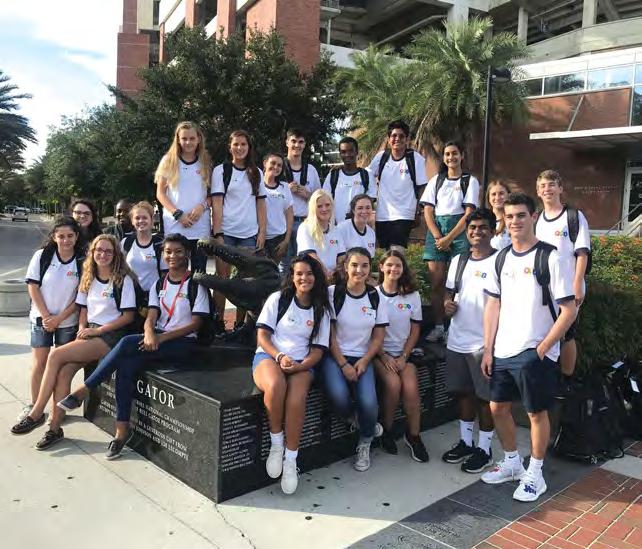

Fresh Salad Recipes For Springtime T he spring season brings to mind flowers blooming and plants springing back to life, making it the ideal time to enjoy fresh produce in meals throughout the day.
Salads are of course one of the easiest ways to combine the flavors of your favorite fruits and veggies, but you can take your greens to the next level with refreshing recipe ideas.
A salad menu is not limited to lunch or appetizers – the Breakfast Salad Bowl makes for an energizing start to the day by combining classic salad ingredients with quinoa, bacon and avocado.
As a more traditional mix to enjoy at the family table, the Salmon and Grains Salad Bowl brings together salmon, tomatoes and chickpeas on a bed of lettuce topped with ranch dressing.
Find more ways to create hearty salads this spring at litehousefoods.com/iheartsalad.
Salmon and Grains Salad Bowl SERVINGS: 2

INGREDIENTS:
• 4 ounces salmon • 2 tablespoons paprika, divided • salt, to taste pepper, to taste • 15 ounces chickpeas • 2 tablespoons olive oil • 2 ounces Fresh Express
Sweet Butter Lettuce • 1 cup red quinoa, cooked • 6 ounces NatureSweet
Cherubs Tomatoes • 2 tablespoons Litehouse
Homestyle Ranch Dressing
DIRECTIONS:
• Heat the oven to 350 degrees F. Sprinkle salmon with one teaspoon of paprika and season it with salt and pepper, to taste. Bake on a lined baking sheet 15 minutes, or until it reaches the desired doneness. • In a bowl, toss the chickpeas in olive oil and the remaining paprika; add salt and pepper, to taste. Add the chickpeas to a lined baking sheet. Bake at 400 F 30-40 minutes. • Add the lettuce to a plate or bowl. Top with quinoa, chickpeas, salmon and tomatoes. Drizzle with ranch dressing.
Breakfast Salad Bowl
SERVINGS: 2
INGREDIENTS:
• 10 ounces NatureSweet Cherubs Tomatoes • 2 tablespoons olive oil, divided • 2 ounces Fresh Express
Baby Spinach • 1 egg • 2 bacon strips, halved • 1 cup quinoa, cooked • 1/2 avocado, sliced • 2 tablespoons Litehouse
Jalapeno Ranch Dressing

DIRECTIONS:
• Heat the oven to 400 degrees F. Toss the tomatoes in one tablespoon of olive oil. Bake the tomatoes on a lined baking sheet for 40 minutes. • In a skillet, add the remaining olive oil and cook the baby spinach until wilted, stirring as necessary. • Cook the egg as desired. Remove the egg from skillet and set aside. Add bacon to the skillet and cook until crispy, turning halfway through. • In a bowl, layer quinoa, bacon, avocado, egg, spinach and tomatoes. Drizzle with jalapeno ranch dressing. (Courtesy of Family Features)

Taco-Stuffed Florida Bell Peppers Healthy Home Cooking
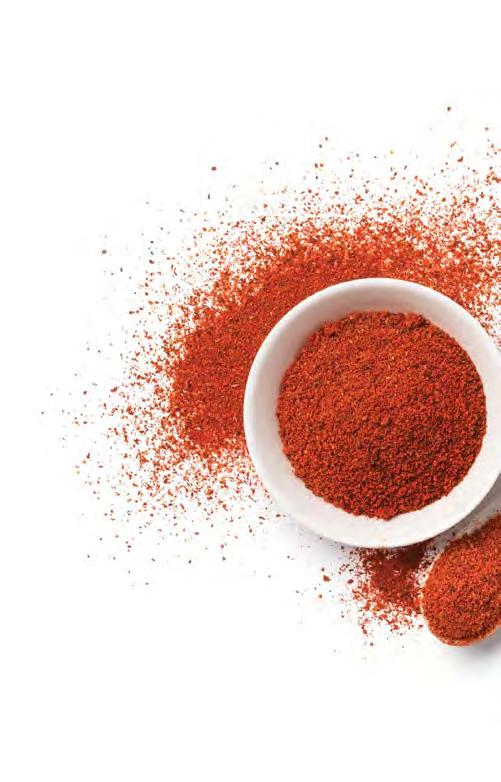

INGREDIENTS:
• 3 large Florida bell peppers (your favorite color), halved lengthwise, seeds removed • 1 pound lean ground Florida beef • 2 cups Florida tomatoes, diced • 1 cup Florida zucchini, diced small • 1 cup Florida squash, diced small • 1 cup onion, chopped • 1 tablespoon garlic, minced • 1 lime, juiced • 1 teaspoon oregano • 1 teaspoon onion powder • 1 teaspoon smoked paprika • 1 teaspoon chipotle chili powder • 1 tablespoon chili powder • 2 cups Colby jack cheese, shredded (or your favorite) • Olive oil, for cooking • Various toppings, such as tortilla chips, sour cream, and cilantro • Sea salt and fresh ground pepper, to taste
DIRECTIONS:
• Preheat a large sauté pan over medium-high heat. Preheat an oven to 375 degrees F. Add olive oil and chopped onion to the preheated pan and cook until translucent. • Add garlic and ground beef to the cooking onions.
Brown the ground beef and drain any excess fat. • Add the lime juice, dry spices, tomatoes, zucchini, and squash; stir to combine. Remove from the heat and let cool slightly. • Add about half of the cheese to the beef mixture and stir to combine. Evenly stuff each pepper half with the beef mixture. Top each stuffed pepper with the rest of the cheese. • Place the stuffed peppers on a cookie sheet and bake in a preheated oven for 15 to 20 minutes. Remove from the oven and let cool slightly. Serve warm with chips, salsa and sour cream. (Courtesy of Florida Department of Agriculture and Consumer Services)







